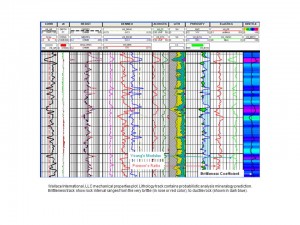Mechanical Properties Modeling
Rock elastic properties are invaluable when designing well casing and mud weight programs, hydraulic (fracture) stimulation design and performing formation failure analysis. Wireline compressional and shear interval transit times and bulk density data can be used to calculate elastic properties. The most important elastic properties, Poisson’s ratio and Young’s modulus, can be used to derive a “brittleness” index. This index provides a simple indicator of likely boundaries needed to contain fracture propagation. When core stress test information is used, the log derived elastic data can be calibrated. The calibrated elastic data is often referred to as static data, and is used with formation stress profiles as an input to frac design software.
Log data must be edited prior to being incorporated into mechanical properties analysis. Often, dipole sonic curves are not directly measured, but are the output of field processing. Often, gaps and bulk shifts in the compressional and shear curves result due to difficulties in processing and data acquisition. These errors must be corrected prior to mechanical properties analysis. Depending on formation properties and drilling methods, light hydrocarbon effects may affect sonic and density data and must be removed prior to calculating elastic properties. A detailed log interpretation allows these corrections to be easily applied.
Often, wells do not have acoustic data and are not considered as candidates for mechanical properties analysis. These wells can be analyzed, when curve reconstruction techniques are used to create synthetic acoustic curves. This requires a nearby well to have the desired data. If nearby well data is not available, then synthetic compressional and shear data can be synthetically created by using a detailed mineralogical description. A multi-mineral probabilistic analysis can be used as the basis of the mineralogical or lithological description.
Wallace International has the knowledge and experience to provide operators with the necessary tools to predict brittleness and provide formation parameters needed to optimally design hydraulic stimulation.
Want to know more about mechanical property evaluations? Call us now at 972.386.4581 or email us at jwallace@wallace-international.com
Thank you for your interest.


Leave A Comment